This article was published in Scientific American’s former blog network and reflects the views of the author, not necessarily those of Scientific American
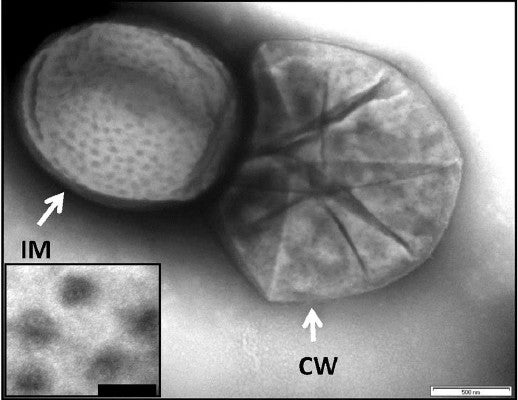
Portrait of a squished bacterium. This one comes with a free prize inside: an apparent bacterial nucleus, complete with nuclear pores, shown enlarged in inset. IM= internal membrane (possible nucleus), CW= cell wall. White scale bar = 500 nanometers, black scale bar = 50 nm. Credit: Sagulenko et al. 2017
Gemmata obscuriglobis excels at breaking rules. Like the platypus, to whom these bacteria have been compared, they possess a baffling arsenal of oddities.
Although it has been controversial, they seem to contain membrane-bound compartments. One of those compartments surrounds their DNA. That would make it, apparently, a nucleus. But bacteria are thought to be devoid of nuclei – hence the terms prokaryote (“pre-kernel”) for bacteria and archaea, and eukaryote (“true kernel”) for all nucleated life (which includes all multicellular organisms).
On supporting science journalism
If you're enjoying this article, consider supporting our award-winning journalism by subscribing. By purchasing a subscription you are helping to ensure the future of impactful stories about the discoveries and ideas shaping our world today.
The eye-popping apparent commonalities don’t end there. Recently, scientists have also observed Gemmata obscuriglobis apparently engulfing its food in a process similar to endocytosis and manufacturing its DNA, RNA, and protein inside special compartments. All of these abilities have long been considered the sole domain of eukaryotes. What had been hitherto unsuspected is that the roster of uncanny similarities extends right down to tiny, intricate holes in the "nucleus".
Inside the cells of each multicellular creature on Earth – and quite a few single-celled ones – are nuclei, DNA storage compartments. However, since access to the DNA is important for things like making proteins, running the cell, and generally staying alive, the nucleus must have a means of egress. For eukaryotes, that means is a nuclear pore, and the nucleus is studded with these structurally complex gates built of many proteins.
Why have a nucleus? Sequestering the genome allows protein production to be much more finely controlled than would otherwise be possible. Having a nucleus, by means of its selective pores, permits the cell to segregate regulatory proteins from DNA -- or to usher them into Club Nucleus along with it. This simple bouncer ability allows us to have much tighter control over which genes get expressed, when, and by how much. Such finely-tuned control may perhaps be part of the reason that all of the multi-cellular organisms on the planet possess a nucleus.
Now scientists from Australia and New Zealand have discovered, in research published in February in PLOS ONE, that embedded in the putative nucleus of G. obscuriglobis are what appear to be gated pores of the same structure and type that stud our nuclei – right down to the way in which the pore proteins are folded.
If that is the case, it means one of two equally astounding things must be true: either this humble bacterium, isolated from freshwater near the Maroon Dam in Queensland, Australia is the closest living relative of eukaryotes, and split from our last common ancestor with bacteria long ago. Or it has independently evolved, under similar pressures, shockingly similar solutions to the same cellular and biochemical problems, right down to the architecture of its nuclear pores.
Here's another view of G. obscuriglobis's putative nucleus (egg-yolk looking object) and pores (its freckles), this time prepared via a different method from the photo at the top of the post.
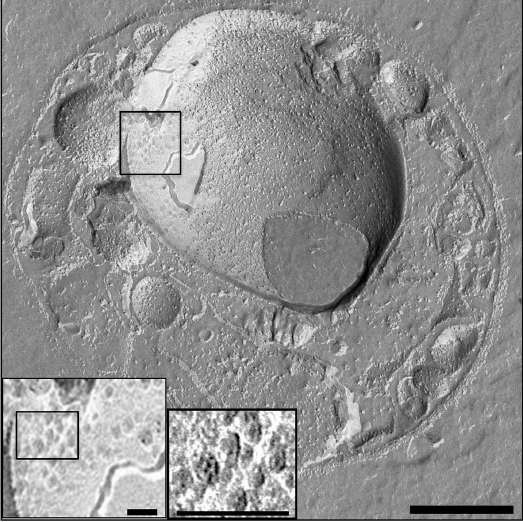
Large image scale bar, 100 nm. Pores visible in box at top and in sequentially enlarged insets at lower left. Credit: Sagulenko et al. 2017
Drilling down to the level of the pores themselves, the uncanny similarities include what this team of scientists interprets as a basket attached to the inside of the membrane and a series of spokes attached to two rings.
Here's a eukaryotic nuclear pore:
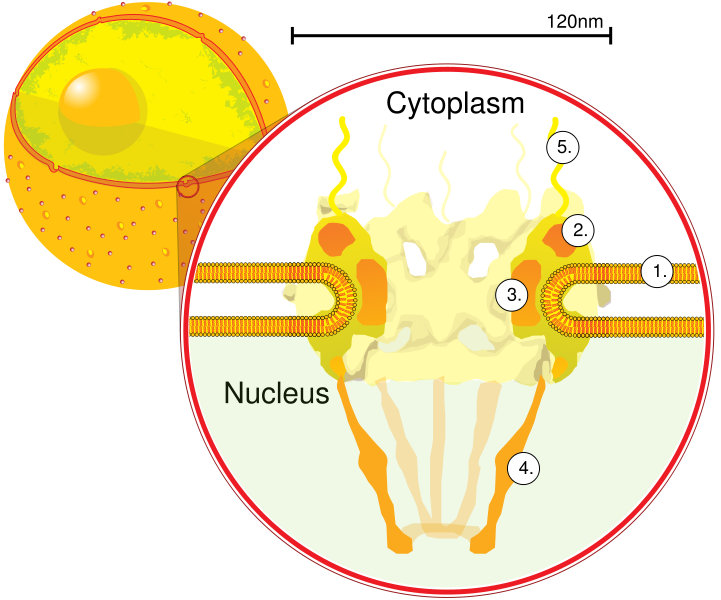
The Eukaryotic nucleus. 1.)Nuclear Envelope 2.)Outer Ring 3.)Spokes 4.)Basket 5.)Filaments Credit: Mike Jones, LadyofHats, R.S. Shaw Wikimedia (CC BY-SA 2.5)
And here is a preliminary model of Gemmata's, based on data in the new study:
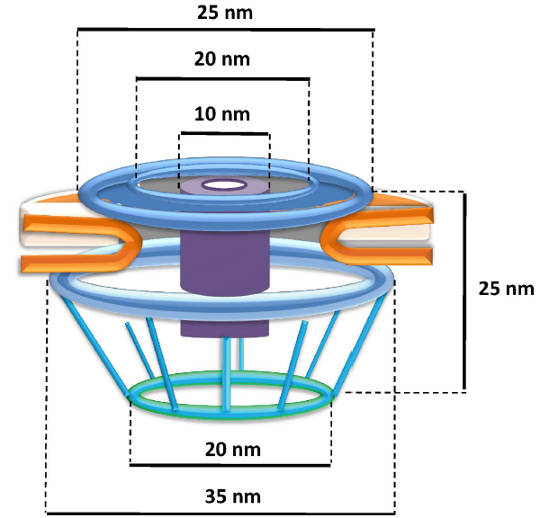
Credit: Sagulenko et al. 2017
Both pores also apparently have octagonal symmetry.
On the nuclear exterior, both eukaryotic and G. obscuriblogis pores look like bullseyes whose target is surrounded by two rings. In the following photo, the long arrows point to the alleged pores.
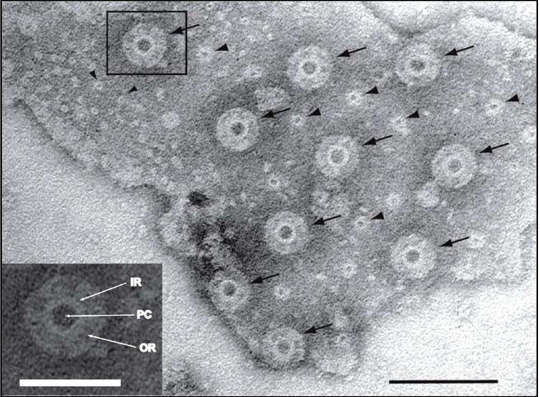
Potential nuclear pores of G. obscuriglobis (long arrows). Arrowheads point to a second type of pore which may just be the back side of the larger pore if the membrane is folded over. Inset shows pore center, inner, ring, and outer ring. Black bar = 100 nm, White bar = 50 nm Credit: Sagulenko et al. 2017
Even the shapes of some of the proteins that compose the pore are strikingly similar. Eukaryotic nuclear pore proteins contain a complex series of folds called a beta-propeller. This structure was also found in eight proteins extracted from the putative nuclear membrane of G. obscuriglobis. Two other bacterial proteins bore substantial resemblance to eukaryotic pore proteins containing a second complex shape called an alpha-solenoid.
There are substantial differences, however. The bacterial pores are much smaller – just about a third of the size of our own. And the actual amino acid sequences of these proteins – proteins are long chains of amino acids -- did not bear a resemblance to eukaryotic versions, indicating they are not simply recent donations from a eukaryote to a bacterium. Whatever their origin, these pores evolved inside bacteria, and most likely have been there a long time.
What does it mean that these bacteria have nuclear pores with architecture astoundingly similar to our own, but whose construction blueprints bear no obvious similarities? The authors of the paper suggest two possibilities. In one scenario, Gemmata shares a common ancestor with the first eukaryotes, and would be our closest living bacterial relative. The sequences are different because so much time has passed since we shared a common ancestor: at least a billion years and probably more. If this is the case, it would make Gemmata extremely important for understanding our evolution.
On the other hand, these structures could have evolved independently in response to similar evolutionary pressures. Perhaps G. obscuriglobis has a strong need, for reasons not apparent right now, for extremely fine-tuned control of its protein production machinery. If so, the bacteria would be yet another example of convergent evolution – a potent force of physical similarity on Earth -- but a particularly striking one. The authors think this second possibility is more likely because of the radical differences in pore sizes and protein composition.
The very existence of G. obscuriglobis also strikes a blow to endosymbiotic theory, the authors suggest. This idea, promulgated most famously by Lynn Margulis but also others, suggest that complex life arose thanks to a series of fusions between bacteria and archaea. Mitochondria – cellular engines -- and chloroplasts – solar panels -- almost certainly formed this way. Some have suggested the cell nucleus shares a similar origin, possibly when a bacterium engulfed an archaeon (the proteins we use to manufacture DNA, RNA and protein bear a strikingresemblance to those of archaea, among other similarities). G. obscuriglobis at least suggests that it is possible to add a fundamental new piece of cellular furniture without the fusion of unrelated microbes.
Reference
Sagulenko, Evgeny, Amanda Nouwens, Richard I. Webb, Kathryn Green, Benjamin Yee, Gary Morgan, Andrew Leis et al. "Nuclear pore-like structures in a compartmentalized bacterium." PLOS One (2017): 076430.